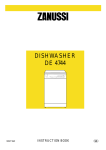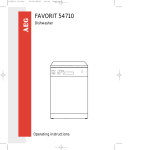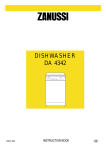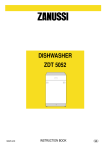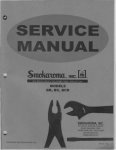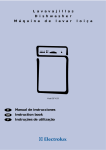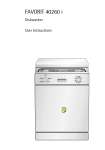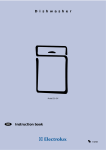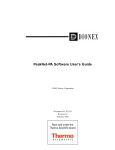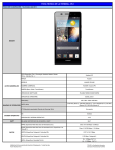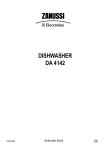Download Electrolux FAVORIT 64800 User's Manual
Transcript
152983 79/2 8-02-2002 17:22 Pagina 1 ÖKO_FAVORIT 64800 Dishwasher Operating instructions 152983 79/2 8-02-2002 17:22 Pagina 2 Dear customer Please read these user instructions carefully. Above all please observe the safety instructions on the first few pages of these user instructions! Please keep these user instructions for later reference. Pass them on to any subsequent owner of the appliance. The warning triangle and/or specific words (Warning!, Caution!, Important!) are used to highlight instructions that are important for your safety or for the function of the appliance. It is imperative that these instructions are observed. Numbered instruction steps lead you step by step through the operation of the appliance. Next to this symbol you receive additional information and practical tips on using the appliance. Tips and instructions for the economical and environmentally conscious use of the appliance are marked with a clover leaf. In the event of a malfunction, these operating instructions contain information on how to rectify faults yourself, see "What to do, if..." section. For further assistance contact your local AEG Service Force Centre, see the chapter "Service & Spare Parts". Printed on paper manufactured with environmentally sound processes. He who thinks ecologically acts accordingly... 2 152983 79/2 8-02-2002 17:22 Pagina 3 Contents Safety instructions 4 Disposing of packaging and old machines Disposing of the packaging Disposing of your old machine Economical and ecological dishwashing 6 6 6 7 Description of the appliance The inside of the appliance Control panel Before using your dishwasher for the first time Setting the water hardness range Filling with special salt The rinse aid 8 8 8 11 11 12 14 Loading cutlery and dishes The lower basket Cutlery basket The upper basket Adjusting the height of the upper basket Use of detergent Bio programmes and compact powders 15 15 16 18 19 20 21 Washing programmes 22 Operating instructions 24 Maintenance and cleaning Internal and external cleaning Cleaning the filters 28 28 28 What do do, if... 30 Service & Spare Parts 32 Guarantee Conditions 33 European Guarantee 34 Hints for test centres 35 Technical data 36 Installation and connection instructions Connecting to the water supply Water outlet connection Water protection system Electrical connection 37 38 38 39 40 3 152983 79/2 8-02-2002 17:22 Pagina 4 Safety instructions The safety of AEG electrical appliances conforms to accepted rules of technology and the Appliance Safety Act. We as manufacturers, however, see ourselves as being obliged to familiarise you with the following safety instructions. Using your dishwasher for its intended purpose ● ● Only use your dishwasher for machine washing of household crockery. If your machine is misused or used for any purposes other than that for which it is intended, the manufacturer cannot be held liable for any damage caused. For safety reasons, you should not convert or modify your dishwasher in any way. Before using your dishwasher for the first time ● ● ● Check your dishwasher for any transport damage. Never connect a damaged machine. If your dishwasher is damaged, you should contact your supplier. Your dishwasher must be correctly installed and connected. Please read the section on "Installation" to make sure you know all about this. Before using your dishwasher for the first time, do not forget that the nominal voltage and current type indicated on the rating plate of your machine must be the same as the nominal voltage and current type at the installation site. The necessary electrical fusing is also given on the rating plate. Child safety ● ● ● ● Packaging parts (e.g. foils, styrene foam) may be dangerous for children,who could even be suffocated! You should therefore keep all packaging well away from children. Children may not recognise the dangers of improper use of electrical appliances. You should therefore ensure proper supervision during operation and not allow your children to play with your dishwasher. Detergents may have a caustic effect on eyes, mouth and throat and may even cause suffocation! Keep all detergents in a safe place out of children’s reach. The water in your dishwasher should not be used for drinking. Detergent residues may still be present in your machine. Keep children well away from your dishwasher when its door is open. Your dishwasher in day-to-day use ● ● 4 ● Never operate your dishwasher if the electrical supply lead, supply or drainhose, control panel, worktop or plinth are damaged. If there is a fault, first turn the water tap off. Then switch off your machine and pull the plug out of the socket. If there is a fixed connection, switch off or unscrew the fuse(s). Never pull the plug out of the socket by the cable - always hold the plug. 152983 79/2 ● ● ● ● ● ● 8-02-2002 17:22 Pagina 5 Dishwasher repairs should only be performed by trained personnel. Improper repairs may seriously endanger the user. If your dishwasher needs to be repaired, you should contact your local AEG Service Force Centre or your retailer. Never place any solvents in your dishwasher or you may cause an explosion! Do not rest or sit on the open door as the machine could tilt. Before using special dishwasher salt, detergent or rinse-aid, make sure that the manufacturer of these products expressly specifies their use in domestic dishwashers. Always turn off the water tap when your dishwasher is left unattended for any length of time, e.g. when you are away on holiday. Only transport the dishwasher in an upright position. Tipping it upside down during transport could cause salty water to leak into the internal compartment and lead to the formation of rust. 5 152983 79/2 8-02-2002 17:22 Pagina 6 Disposing of packaging and old machines Disposing of the packaging Our dishwashers require effective protective packaging in transit, though we always confine ourselves to what is absolutely necessary. Warning! Packaging parts (e.g. foils, styrene foam) may be dangerous for children and can cause suffocation. You should therefore keep all packaging well away from children. All packaging materials used are environmentally compatible and reusable. The cardboard parts are produced from recycled paper, and the wood is untreated. The plastics are marked as follows: >PE< for polyethylene, e.g. packaging foils. >PS< for polystyrene, e.g. padding (essentially CFC-Free). >POM< for polyoxymethylene, e.g. plastic clamps. Give the packaging for reuse to your local recycling centre. Your municipal or local authority will give you its address. Disposing of your old machine When your machine finally reaches the end of its life and you withdraw it from service, you should render it unserviceable before having it disposed of. Warning! Children at play could lock themselves in your machine (and suffocate) or otherwise endanger their lives. Therefore pull out the main plug and detach and discard the electrical supply lead. Disable the door lock so that the door no longer closes. Marking of plastic parts for graded recycling: all plastic parts in your machine are marked with internationally standardised abbreviations (e.g. <PS> for polystyrene). When your machine is disposed of, this enables plastic waste to be sorted into individual types for environmentally conscious recycling. Check with your local Council or Environmental Health Office to see if there are facilities in your area for recycling the appliance. 6 152983 79/2 8-02-2002 17:22 Pagina 7 Economical and ecological dishwashing ● Ensure that the water softener is correctly adjusted. ● Do not pre-rinse under running water. ● Select the wash programme to suit the nature and degree of the soiling on the dishes. ● Do not use more detergent, special salt or rinse aid than is recommended in these operating instructions and by the manufacturer of the respective product. 7 152983 79/2 8-02-2002 17:22 Pagina 8 Description of the appliance The inside of the appliance 1. Upper basket stop 2. Upper spray arm 3. Salt container 4. Detergent dispenser 5. Control panel 6. Rinse aid dispenser 7. Filters 8. Lower spray arm 9. Upper basket 10. Worktop IN111 Control panel 1. ON/OFF indicator light 2. ON/OFF push button 3. Programme selector push buttons 4. Door handle 5. Digital display 8 152983 79/2 8-02-2002 17:22 Pagina 9 6. "SMALL LOAD" push button This is very useful and economical when only a few dishes need washing. Remember to load the crockery into both baskets. The indicator light corresponding to this option will come on when selected. 7. Programme phase indicator lights As soon as you select a washing programme, this illuminates all the phases the programme consists of. As the programme progresses, the phase under way will illuminate. At the end of the programme the phase indicator lights turn off. 8. Indicator lights SALT Illuminates when the salt has run out, to remind you to refill the salt container. RINSE - AID Illuminates when the rinse aid has run out, to remind you to refill the rinse aid dispenser. WATER Flashes when: - The water tap is closed. - The mains supply has been cut off. - The inlet hose may be blocked. DOOR Flashes when the door has not been properly closed. 9. "DELAY START" push button Allows the start of the programme to be delayed by a minimum of 1 hour, up to 12 hours. 9 152983 79/2 8-02-2002 17:22 Pagina 10 Audible signals have been introduced to help indicate which operations the dishwasher is performing. "Instruction accepted" audible signal When any of the push buttons are pressed, an audible signal informs you that the machine has accepted the instruction given. "Programme run" audible signal An audible signal informs you that the washing programme is starting. "End of programme" audible signal An intermittent audible signal informs you that the wash programme has ended. "Alarm" audible signal The machine is fitted with a number of alarm systems to help you determine the cause of any problems (see "What to do, if...). An audible signal informs you that an alarm is activated. To deactivate these audible signals, press the "SMALL LOAD" push button for about 3 seconds, at the end of which an audible signal informs you that the audible signals have been deactivated. SO320 To reactivate these audible signals, press the "SMALL LOAD" push button for about 3 seconds, at the end of which an audible signal informs you that the audible signals have been reactivated. Both operations (to deactivate or reactivate the audible signals) must be carried out before starting a washing programme; the setting will remain memorised after switching off the dishwasher. 10 152983 79/2 8-02-2002 17:22 Pagina 11 Before using your dishwasher for the first time 1. Ensure that the electrical and water connections comply with the installation instructions. 2. Remove all packaging from inside the appliance. 3. Set the water softener. 4. Pour half a litre of water inside the salt container and then fill with salt. 5. Fill the rinse-aid dispenser. Setting the water hardness range The dishwasher is equipped with a water softener designed to remove minerals and salts from the water supply, which would have a detrimental or adverse effect on the operation of the appliance. The higher the content of these salts, the harder your water is. Water hardness is measured in equivalent scales, German, French degrees and PPM (parts per Million). The softener should be adjusted according to the hardness of the water in your area. Your local Water Authority can advise you on the hardness of the water in your area. The dishwasher is factory set at level 4. If this level is not suitable for your area the softener should be adjusted. Water hardness Level °dH °TH (german degrees) (french degrees) 0 1 2 3 4 5 6 7 8 9 0-4 5-8 9 - 11 12 - 17 18 - 22 23 - 28 29 - 33 34 - 39 40 - 45 46 - 50 0-8 9 - 14 15 - 20 21 - 30 31 - 40 41 - 50 51 - 60 61 - 70 71 - 80 81 - 90 PPM Use of salt (parts per million) 0 - 80 81 - 140 141 - 200 201 - 300 301 - 400 401 - 500 501 - 600 601 - 700 701 - 800 801 - 900 NO YES YES YES YES YES YES YES YES YES If your water hardness is level 1 it is already soft and therefore there is no need to use salt. With the setting of the water softener at level 0 the salt indicator light on the control panel will always remain off. 11 152983 79/2 8-02-2002 17:22 Pagina 12 To set a different level, proceed as follows: 1. Press the ON/OFF push button. 2. Press the "SMALL LOAD" and "DELAY START" push buttons simultaneously for about 5 seconds, in the display will appear L4 which corresponds to the current level. 3. Press the "DELAY START" push button as many times as necessary until the required level appears in the display. The level increases by 1 each time the push button is pressed. 5 seconds after this push button has last been pressed the dishwasher memorises the level selected and returns to the programme setting mode. SO321 Filling with special salt Caution! The packaging of dishwasher salt and detergents are often very similar. The accidental filling of the salt compartment with detergent would ruin the water softener. Each time you add salt, make sure the carton you have in your hand really is salt. Only use salt specifically designed for use in dishwashers. All other types of salt not specifically designed for use in a dishwasher, especially table salt, will damage the water softener. Only fill with salt just before starting one of the complete washing programmes (not the "Rinse and hold" programme). This will prevent any grains of salt or salty water, which may have been spilled, remaining on the bottom of the machine for any period of time, which may cause corrosion. 12 152983 79/2 8-02-2002 17:22 Pagina 13 To fill: 1. To fill with salt, unscrew the cap of the salt container. 2. Pour half a litre of water inside the container (this is necessary only before filling with salt for the first time). 3. Using the funnel provided, pour in the salt until the container is full. Do not worry if water overflows from the unit when filling with salt, this is quite normal. LE SA LT SA LZ SA L SE 4. Replace the cap making sure that there is no trace of salt on the screw thread or on the gasket. 5. Screw on the cap tightly. SR14 When this has been done, all that is required is to periodically top up the container with salt. You are reminded of this by the salt indicator light on the control panel which will illuminate when the salt has finished. Important! The salt refill indicator light on the control panel can remain illuminated for 2-6 hours after salt has been replenished, assuming the dishwasher remains on. If you are using salts that take longer to dissolve then this can take longer. the function of the dishwasher is not affected. 13 152983 79/2 8-02-2002 17:22 Pagina 14 The rinse-aid The rinse-aid ensures brilliant crockery and also helps it to dry. It is automatically dosed in during the hot rinsing cycle. The storage compartment built in to the inside of the door can hold about 110 ml of rinse-aid, which will be sufficient for between 16 and 40 dishwashing programmes, according to the dosage setting. Filling up the rinse-aid 1. Open the container by turning the lid (A) anticlockwise. 2. Add the rinse aid until the container is completely full. The indicator (B) will be completely dark. Ensure that the lid is closed after every refill. Top up with rinse aid when the indicator (B) becomes clear. BR01 Clean up any rinse aid spilt during filling with an absorbent cloth to avoid excess foaming during the next wash. Attention! Do not put liquid detergent in the rinse aid compartment. Adjusting the dose The correct dosage of the rinse-aid should be regulated on the basis of the shine and drying results. BR03 For this purpose, set the quantity of liquid by means of the six-position selector (C) located on the inside of the filler opening (minimum quantity is position 1, maximum quantity is position 6). Use the tip of a screwdriver to rotate the selector. If drops of water or white marks remain on the crockery after it has been washed, increase the dosage. If the crockery comes out with whitish, sticky streaks, reduce the dosage. 14 BR02 152983 79/2 8-02-2002 17:22 Pagina 15 Loading cutlery and dishes Sponges, household cloths and any object that can absorb water must not be washed in the dishwasher. For washing in the dishwasher the following cutlery/dishes are not suitable: ● Cutlery with wooden, horn, china or mother of pearl handles. ● Plastic items that are not heat resistant. ● Older cutlery with cement that is not temperature resistant. ● Bonded cutlery items or dishes. ● Pewter or copper items. ● Lead crystal glass. ● Steel items subject to rusting. ● Wooden platters. ● Items made from synthetic fibres. are of limited suitability: ● Only wash stoneware in the dishwasher if it is specifically marked as being dishwasher-safe by the manufacturer. ● Glazed patterns may fade if machine washed frequently. ● Silver and aluminium parts have a tendency to discolour during washing. Left-overs, e.g. egg white, egg yolk and mustard often cause discolouring and staining on silver. Therefore always clean left-overs from silver immediately, if it is not to be washed straight after use. ● Some types of glass can become dull after a large number of washes. Attention! When buying new dishes, ensure that they are dishwasher proof. Before placing dishes in the machine, remove any scraps of food, to avoid clogging the filters and consequently reducing the performance. Do not load very small items which can fall through the baskets. Open the door and slide out the baskets. The lower basket The lower basket is designed to take saucepans, lids, plates, salad bowls, cutlery etc. Serving dishes and large lids should be arranged around the edge of the basket, ensuring that the upper spray arm can turn freely. UI51 UI12 15 152983 79/2 8-02-2002 17:22 Pagina 16 The two rear rows of prongs on the lower basket can be easily lowered to allow you to load pots, pans and bowls. To lower the prongs: 1. Slightly pull them upward and let them drop down (see picture). 2. To bring them back to the standing position, just pull them up again. UI84 UI83 Removable knife basket Long and/or sharp items of cutlery such as carving knives must be placed horizontally in the removable knife basket, which is positioned at the left of the upper basket. UI55 Cutlery basket 16 Place knives, forks and spoons in the cutlery basket with their handles pointing downwards. Arrange cutlery loosely and distribute it in all compartments so that each individual article has good contact with washing water. Also do not arrange spoons and forks with their dirty side in contact with each other. Important! Exceptionally long cutlery, such as soup ladles, kitchen knives, or the like, may obstruct the upper spray arm. Such cutlery can be placed in the upper basket. To unload your dishwasher more easily, you can take the cutlery basket out of the lower basket and unfold it. this makes it easier to remove small pieces of cutlery. Important note! To prevent the full cutlery basket from inadvertently unfolding when being taken out, place your hand right round the two-piece handle and hold it firmly. 152983 79/2 8-02-2002 17:22 Pagina 17 1. Place the cutlery basket on a firm support (table, worktop) and unfold both handle parts. 2. After unloading, fold back both handle parts. UI25 UI20 Long bladed knives stored in an upright position are a potential hazard. Long and/or sharp items of cutlery such as carving knives must be positioned horizontally in the upper basket. Take care when loading or unloading sharp items such as knives. 17 152983 79/2 8-02-2002 17:22 Pagina 18 The upper basket The upper basket is designed for plates (dessert plates, saucers, dinner plates up to 24 cm in diameter), salad bowls, cups and glasses; these should be arranged as shown in the pictures. Glasses with long stems can be placed upside-down in the raised cup-racks. The cup-rack on the left folds upwards to increase your loading flexibility. Arrange items on and underneath the folddown cup racks so that water can reach all surfaces. Light items (plastic bowls etc.) should be loaded in the upper basket and arranged so they do not move. US60 Before closing the door, ensure that the spray arms can rotate freely. 18 152983 79/2 8-02-2002 17:22 Pagina 19 Adjusting the height of the upper basket If washing very large plates (over 27 cm and up to 31 cm in diameter) you can load them in the lower basket after moving the upper basket to the higher position. To move to the higher position proceed as follows: 1. Move the front runner stops (A) of the upper basket outwards and slide the basket out. 2. Refit the basket in the higher position and replace the stops (A) in their original position. RC01 Attention! When the top basket is in the higher position it will only take plates up to 20 cm in diameter and you will not be able to use the raised cup racks. After loading your machine always close the door, as an open door can be a hazard. 19 152983 79/2 8-02-2002 17:22 Pagina 20 Use of detergent Attention! Only use detergents specifically designed for use in dishwashers. If using powder detergents proceed as follows: 1. Open the dispenser lid by pulling the catch (D). 2. Add the detergent. As all detergents are not the same, please pay attention to the dosage instructions from the manufacturer of your brand. 3. Always close the lid. 4. If the programme has a prewash add the required detergent over the lid of the dispenser. DE17 If using detergent in tablets proceed as follows: 1. For all programmes; place 1 tablet inside the detergent dispenser. 2. Always close the lid. DE02 3. For all programmes with prewash; place a portion of a further tablet on the lid of the detergent dispenser. At the end of any washing programme the lid is always open, ready for the next wash. Since not all detergents are the same, you should also consult the instructions on the packet. 20 152983 79/2 8-02-2002 17:22 Pagina 21 Remember that insufficient quantities of detergent will produce poor washing results whereas an excessive amount of detergent does not improve washing results and is also wasteful. Using no more than the correct amount of detergent also contributes to reducing pollution. BIO programmes and compact powders On the basis of their chemical composition, dishwasher detergents can be classified into two groups: - conventional, alkaline detergents with caustic components: low-alkaline compact powders with natural enzymes. The enzymes in low-alkaline compact powders have a dirt-dissolving effect and are also biodegradable. These enzymes deploy their full dirt-dissolving power within a temperature range of 40-50°C. In BIO washing programmes, the temperature range and duration of the heating phases are precisely matched to the dirt-dissolving properties of the enzymes. In combination with low-alkaline compact powders, BIO washing programmes, at a temperature as low as 50°C, therefore achieve the same cleaning results that would otherwise be achievable only with 65°C programmes. The lack of any caustic components in low-alkaline compact powders and the lower cleaning temperature of BIO washing programmes are not only environmentally friendly, but also care for your crockery. 21 152983 79/2 8-02-2002 17:22 Pagina 22 Washing programmes Programmes INTENSIVE 70° Type of soil Type of load Heavy soil. Crockery, cutlery, pots and pans Required push buttons ON OFF INTENSIVE 70° ON OFF NORMAL 65° NORMAL 65° Normal soil. Crockery and cutlery NORMAL BIO 50° Light soil. Crockery and cutlery ON OFF NORMAL BIO 50° ECO BIO 50° Normal soil. Crockery and cutlery ON OFF ECO BIO 50° * QUICK Light soil. Crockery and party crockery ON OFF QUICK 50° Partial load to be completed later in the day. This programme does not require detergent. ON OFF PREWASH 50° PREWASH * This is a quick wash programme for a full load of lightly soiled dishes, glasses and crockery (except pots) so that you may re-use them promptly. Due to the shortness of this programme, no drying phase is provided. 22 152983 79/2 8-02-2002 17:22 Pagina 23 Approximate values ** Cycle description Programme duration in minutes Energy consumption in kWh Water consumption in litres Hot prewash Main wash up to 70°C 2 cold rinses 1 hot rinse Turbo drying 105 - 115 1,4 18 Warm prewash Main wash up to 65°C 1 cold rinse 1 hot rinse Turbo drying 90 - 100 1,2 15 Cold prewash Main wash up to 50°C 1 cold rinse 1 hot rinse Turbo drying 90 - 100 1,1 15 Cold prewash Main wash up to 50°C 1 cold rinse 1 hot rinse Turbo drying 135 - 145 0,8 14 Main wash up to 50°C 1 cold rinse 1 hot rinse 35 - 45 0,7 11 10 0,1 8 1 cold rinse (to avoid food scraps from sticking to the dishes). ** The times and consumption values are intended as a guide, and depend on the pressure and temperature of the water and also by the variations of the power supply. 23 152983 79/2 8-02-2002 17:22 Pagina 24 Operating instructions 1. Check the filters Ensure they are clean and properly positioned (see "Maintenance and cleaning"). 2. Press the ON/OFF push button The ON/OFF indicator light will illuminate and three horizontal lines (- - - ) will appear in the digital display. 3. Check that there is rinse aid and salt The corresponding indicator lights will illuminate if refilling is necessary. 4. Load the dishes Remove any scraps of food. Pull the lower basket out and arrange the saucepans, plates and cutlery in it. Pull the upper basket out and arrange the plates, saucers, glasses and cups etc. in it. Slide the baskets back into the machine. 5. Ensure that the spray arms can rotate freely. 6. Add the detergent As all detergents are not the same, you should also consult the instructions on the packet. Close the detergent dispenser lid. 7. Open the water tap The setting of the programme may occur: With open door, in this case the selected programme and eventual options (small load and/or delay start) will start automatically 5 seconds after the closure of the door. With closed door, in this case the selected programme and eventual options (small load and/or delay start) will start automatically 5 seconds after the last pressure of a push button. 24 152983 79/2 8-02-2002 17:22 Pagina 25 8a. Set and start the programme without "DELAY START" ● ● ● ● ● Select the wash programme by simply pressing one of the programme push buttons, the display will show the running time of the programme in minutes and the indicator lights of the phases corresponding to the programme will illuminate. If necessary select the "SMALL LOAD" by pressing the corresponding push button (in this case the running time of the programme will be adjusted). With the selection of the programmes "QUICK 50°" and "PREWASH" this option is not available. If the setting of the programme has been made with the door opened: close the door and the programme will start automatically after 5 seconds. While the door remains open you still have the chance to modify the setting made. If the setting of the programme has been made with the door closed: the programme will start automatically after 5 seconds from the last pressure of a push button. The starting of the programme will be confirmed by an audible signal, the indicator lights of the phases turn off except for the light of the phase under way. The displayed time will start to decrease from minute to minute. 8b. Set and start the programme with "DELAY START" ● ● ● ● Select the wash programme by simply pressing one of the programme push buttons, the display will show the running time of the programme in minutes and the indicator lights of the phases corresponding to the programme will illuminate. If necessary select the "SMALL LOAD" by pressing the corresponding push button (in this case the running time of the programme will be adjusted). With the selection of the programmes "QUICK 50°" and "PREWASH" this option is not available. Press the "DELAY START" push button, in the display appears h1. Select the time by repeatedly pressing the "DELAY START" push button until the required number of hours appear in the display. You can delay the start of a programme up to a maximum of 12 hours (h12). To cancel the setting of the delay start press the push button until the running time of the selected programme reappears in the display. If the setting of the programme has been made with the door opened: close the door and the dishwasher starts the countdown automatically after 5 seconds. The number of hours to go before the programme starts appears in the display and decreases from hour to hour. The letter h flashing in the display indicates that the delay start is active. 25 152983 79/2 ● ● 8-02-2002 17:22 Pagina 26 If the setting of the programme has been made with the door closed: the dishwasher will start the countdown automatically after 5 seconds from the last pressure of a push button. Once the delay set has elapsed the programme will start automatically, the indicator lights of the phases turn off except for the light of the phase under way. The displayed time will start to decrease from minute to minute. 9. At the end of the washing programme ● ● ● The dishwasher will automatically stop and an audible signal informs you that the programme has ended. In the display appears 000 and the indicator lights of the programme and phases turn off. The washing programme has ended completely only when you hear an audible signal and the indicator lights of the programme and of the phases (included drying phase) will turn off. If you do not wait for the end of the washing programme it will not be possible to set a new programme, if not after having cancelled the previous one. Press the ON/OFF push button to switch the dishwasher off and open the door. Wait a few minutes before removing the dishes, in this way they will be cooler and the drying will be improved. Empty the lower basket first and then the upper one, this will avoid water dripping from the upper basket onto the dishes in the lower one. When the wash programme has finished, it is recommended that the dishwasher is unplugged and the water tap turned off. 10. To cancel a programme ● ● ● ● 26 This is possible either with an open or closed door. To cancel a wash programme in progress, press for about 5 seconds the push button of the programme in progress. Once past 5 seconds the dishwasher returns to setting mode and a new washing programme can be selected. This is valid also for the delay start. During the setting of a programme with the door open, to cancel the setting simply press the ON/OFF push button. Before the elapse of the 5 seconds from the last pressure of a push button, to cancel the setting simply press the ON/OFF push button. 152983 79/2 8-02-2002 17:22 Pagina 27 Caution! In general it is not advisable to open the door while the machine is working; if the door is opened however, a safety device ensures that the machine stops. A programme underway is interrupted when you open the door. - Close the door again. The programme will start again at the point it was interrupted. Caution! Opening the door could let very hot steam escape: you risk being scalded! Open the door with great care. Do not open the door during the hot phase: this may cause hot water to escape. 27 152983 79/2 8-02-2002 17:22 Pagina 28 Maintenance and cleaning Internal and external cleaning Do not under any circumstances use furniture care products or aggressive cleaners. If necessary, clean the controls only with a soft cloth and clean warm water. The spray arms do not need cleaning. Occasionally check the internal containers, door seal and water inlet for soiling, clean if necessary. We recommend every 3 months to run a 65°C wash programme without dishes using detergent. Cleaning the filters The filters in the base of the washing compartment are to a large extent selfcleaning. Nevertheless the filters should be checked and cleaned from time to time. Dirty filters will degrade the washing result. 1. Open the door, remove the lower basket. 2. The dishwasher filter system comprises a coarse/fine filter, microfilter and a flat filter. Unlock the filter system using a handle on the microfilter, and remove. 3. Turn the handle about 1/4 a turn anticlockwise and remove. MA15 4. Take hold of the coarse/fine filter (1/2) by the handle with the hole and remove from the microfilter (3). 5. Clean all filters thoroughly under running water. MA17 28 152983 79/2 8-02-2002 17:22 Pagina 29 6. Remove the flat filter (4) from the base of the washing compartment and clean both faces thoroughly. 7. Put the flat filter back in the base of the washing compartment. 8. Place the coarse/fine filter in the microfilter and press together. MA16 4 9. Put the filter combination in place and lock by turning the handle clockwise to the stop. During this process ensure that the flat filter does not protrude above the base of the washing compartment. Under no circumstances must the dishwasher be used without filters. 29 152983 79/2 8-02-2002 17:22 Pagina 30 What to do, if... Try to rectify minor faults on the dishwasher with the aid of the instructions given here. ...a flashing fault code appears an audible signal informs you that an alarm has been activated, in the display appears one of the following flashing alarms: AL1 - AL2 - AL3 - AL4 - AL5 - AL6 AL7 and the indicator light of the phase under way is flashing. They are indicative of a fault in the dishwasher that you can probably rectify yourself. - Press the ON/OFF push button to switch the dishwasher off. - Open the door and carry out the following suggested corrective actions. Fault code "DOOR" indicator light flashes "WATER" indicator light flashes and/or alarm AL5 Alarm AL6 Alarm AL4 Alarms AL1 - AL2 - AL3 AL7 - AL8 Possible cause Remedy The door has not been properly closed. Close the door. The water tap is closed. Open the water tap. The mains water supply has been cut off. Wait for the supply to be restored. The inlet hose may be squashed or bent. Reposition correctly the hose. The inlet hose may be blocked. Switch off the water supply and clean the filter. The drain hose may be squashed or bent. The drain hose extension is not correct. Reposition correctly the drain hose. Follow the instructions for connecting to the waste. The sink may be blocked. Clear any blockages. Protection against flooding is active. Close the water tap and contact the Service Force Centre. General Switch off the dishwasher, switch back on and start a wash programme. If the fault code reappears contact the Service Force Centre. Once you have checked the possible causes listed above, switch on the dishwasher and start a wash programme, if the fault code reappears contact the Service Force Centre. 30 152983 79/2 8-02-2002 17:22 Pagina 31 ...problems occur during use of the dishwasher Malfunction The programme does not start Possible cause Remedy The plug is not properly inserted in the power socket. Insert the plug. There is a power failure. Check the fuse. The dishwasher has not ended the previous washing Cancel the previous setted programme. cycle. (See paragraph concerning "At the end of the washing programme". The machine is noisy The door is difficult to close Dishes are rattling against each other. The spray arms are knocking against the dishes. Load correctly crockery, cutlery, pots and pans. Refer to "Loading cutlery and dishes" The dishwasher is not level, or not properly built-in. Refer to "Installation" instructions. ...the wash results are not satisfactory Visible lime deposits or white film on the dishes ● ● Check that the right level of the water softener is set. Check that there is salt. The dishes are not quite dry ● The rinse aid has run out or too little is being used. The dishes are not clean ● ● ● ● ● ● ● ● ● The baskets are too full. The dishes have not been arranged properly. The spray arms do not rotate because of incorrect loading of the baskets. The filters are clogged. The filters are not in position. Not enough detergent has been used or it is unsuitable. The detergent is old or has gone hard. The salt container cap is not properly closed. The washing programme is too gentle. 31 152983 79/2 8-02-2002 17:22 Pagina 32 Service & Spare Parts In the event of your appliance requiring service, or if you wish to purchase spare parts, contact your local AEG Service Force Centre by telephoning 08705 929 929 Your call will be automatically routed to the Service Centre covering your post code area. For the address of your local Service Force Centre and further informations about Service Force, please visit the website at www.serviceforce.co.uk Help us to help you Please determine your type of enquiry before writing or telephoning. When you contact us we need to know, 1 2 3 4 5 Your name, address and post code Your telephone number Clear and concise details of the fault code Date of purchase . No. Prod. ....... . Ser. No. ....... .. E-NR (product number) F-NR (serial number) This information can be found on the rating plate located on the right inside edge of the door. ....... ● Mod. ● E- NR ...... F-NR ...... Customer Care For general enquiries concerning your AEG appliance, or for further information on AEG products, you are invited to contact our Customer Care Department by letter or telephone at the address below or visit our website at www.aeg.co.uk Customer Care Department AEG Domestic Appliances 55-77 High Street Slough Berkshire SL1 1DZ Tel.: 08705 350350 (*) * calls to this number may be recorded for training purposes 32 152983 79/2 8-02-2002 17:22 Pagina 33 Guarantee Conditions AEG offer the following guarantee to the first purchaser of this appliance: 1. The guarantee is valid for 12 months commencing when the appliance is handed over to the first retail purchaser, which must be verified by purchase invoice or similar documentation. The guarantee does not cover commercial use. 2. The guarantee covers all parts or components which fail due to faulty workmanship or faulty material. The guarantee does not cover appliances where defects or poor performance are due to misuse, accidental damage, neglect, faulty installation, unauthorised modification or attempted repair, commercial use or failure to observe requirements and recommendations set out in the instruction book. This guarantee does not cover such parts as light bulbs, removable glassware or plastic. 3. Should guarantee repairs be necessary the purchaser must inform the nearest customer service office (AEG’s service or authorised agent). AEG reserves the right to stipulate the place of the repair (i. e. the customer’s home, place of installation or AEG workshop). 4. The guarantee or free replacement includes both labour and materials. 5. Repairs carried out under guarantee do not extend the guarantee period for the appliance. parts removed during guarantee repairs become the property of AEG. 6. The purchaser’s statutory rights are not affected by this guarantee. 33 152983 79/2 8-02-2002 17:22 Pagina 34 European Guarantee If you should move to another country within Europe then your guarantee moves with you to your new home subject to the following qualifications: ● The guarantee starts from the date you first purchased your product. ● ● ● ● ● The guarantee is for the same period and to the same extent for labour and parts as exist in the new country of use for this brand or range of products. This guarantee relates to you and cannot be transferred to another user. Your new home is within the European Community (EC) or European Free Trade Area. The product is installed and used in accordance with our instructions and is only used domestically, i. e. a normal household. The product is installed taking into account regulations in your new country. Before you move please contact your nearest Customer Care Centre, listed below, to give them details of your new home. They will then ensure that the local Service Organisation is aware of your move and able to look after you and your appliances. 34 France Senlis +33 (0) 3 44 62 29 29 Germany Nürnberg +49 (0) 800 234 7378 Italy Pordenone +39 (0) 800 117511 Sweden Stockholm +46 (0) 8 672 53 60 UK Slough +44 (0) 1753 219899 Ireland Dublin +353 (0) 14090753 152983 79/2 8-02-2002 17:22 Pagina 35 Hints for test centres Before starting any test it is necessary to fill completely with salt the salt container and with rinse aid the rinse aid dispenser. Test standard EN 50242 Reference programme - ECO BIO 50° Load 9 standard place settings Rinse aid selector position 4 Detergent dosage - 20 g in the dispenser - 5 g on the dispenser lid UI51 US65 Arrangement upper basket Arrangement lower basket 35 152983 79/2 8-02-2002 17:22 Pagina 36 Technical data Technical specifications Dimensions Width Height with worktop Height without worktop Max depth Max depth with open door Electrical connection Motor rating during wash Power of heating element Overall power Water supply pressure Capacity 45 cm 85 cm 82 cm 60 cm 115,2 cm 220/240 V - 50 Hz 200 W 2100 W 2300 W Minimum Maximum 50 kPa (0.5 bar) 800 kPa (8 bar) 9 place settings This appliance complies with the following E.E.C. Directives: - 73/23/CEE of 19/02/73 (Low Voltage Directive) and subsequent modifications; - 89/336/CEE of 03/05/89 (Electromagnetic Compatibility Directive) and subsequent modifications. 36 152983 79/2 8-02-2002 17:22 Pagina 37 Installation and connection instructions Adjusting the worktop You can move the worktop forward or backward by 25 mm in order to align the machine with other kitchen units. Simply unscrew the two front retaining screws, move the top to the required position and then retighten the screws. IN02 Fitting under a counter (kitchen worktop or sink) By removing the machine’s worktop, you can install it under a close fitting sink unit or a preexisting top, providing the dimensions of the recess correspond to those shown in the picture. 820 570600 Proceed as follows: - Remove the machine’s worktop by 450 unscrewing the two front retaining screws, pull from the front and slide out the rear slots, lifting the worktop. IN04 Insert the machine after adjusting height and levelling with the adjustable feet. When inserting the machine, ensure that the water inlet and drain hoses are not kinked or squashed. Levelling Good levelling is essential for correct closure and sealing of the door. When the appliance is correctly levelled, the door will not catch on the levelling spacers on either side of the cabinet. If the door does not close correctly, loosen or tighten the adjustable feet until the machine is perfectly level. IN06 IN07 37 152983 79/2 8-02-2002 17:22 Pagina 38 Connecting the water supply ● Your dishwasher should be connected to a cold water supply. ● Never connect your dishwasher to open hot water appliances and continuous flow heaters! We advise you use a cold water supply because a hot water supply is not always efficient with very soiled crockery as it shortens the washing programmes. Do not use, for connection, old hoses which have been used in another appliance. Avoid bends or kinks in the hose which could prevent or slow down the water supply. If the machine is connected to new pipes or pipes which have not been used for a long time, you should run the water for a few minutes before connecting the inlet hose. This will prevent deposits of sand or rust clogging the inlet hose. The water pressure must be within the limits given in the technical specifications. Your dishwasher has been built in accordance with the valid regulations governing water-consuming appliances and is equipped with safety devices which prevent used water from flowing back into the drinking water mains. Water outlet connection The end of the drain hose can be connected as follows: 1. To the sink outlet siphon, securing it if necessary with a clip. 2. Hooked over the edge of the sink using the special curved plastic guide provided. 3. To a wall outlet provided with vent-hole, minimum internal diameter 4 cm. 2 min 4 cm 3 Ø min 30 cm max 100 cm max 100 cm Ø 18 21 1 CS09 38 The waste connection must be at a height of between 30 cm (minimum) and 100 cm (maximum) from the floor. It makes no difference which way the drain hose faces, either to the right or left of the dishwasher. Avoid bending or kinking the hose as this could prevent or slow down the discharge of water. 152983 79/2 8-02-2002 17:22 Pagina 39 Extension hoses min 30 cm max 100 cm + 2 m max max 100 cm Ø 18 Ø 21 The necessary extension hoses can be obtained from specialist shops or from your local Service Force Centre. The extension hose must be no longer than 2 metres and its internal diameter must be no smaller than the diameter of the hose provided. Likewise the internal diameter of the couplings used for connection to the waste outlet must be no smaller than the diameter of the drain hose. Arrange the extension hose horizontally along the floor and allow it to rise only where it is to be connected to the drain. CS10 Water protection system To protect your dishwasher from water damage, it is equipped with a water protection system. In all cases of malfunction a fault code will appear on the control panel. The fault is recognised by the fact that in the digital display a flashing "AL4" will appear, in this case turn off the water tap and call the Service Force Centre. 39 152983 79/2 8-02-2002 17:22 Pagina 40 Electrical connection If the plug that is fitted to your appliance is not suitable for the socket, it must be cut off and the appropriate plug fitted. Important! The wires on the mains lead are coloured in accordance with the following code: Green and Yellow -Earth Blue -Neutral Brown -Live If you fit your own plug, the colours of the wires in the mains lead of your appliance may not correspond with the markings identifying the terminals in your plug. Proceed as follows: 1. Connect the Green and Yellow (earth) wire to the terminal in the plug which is marked with the letter "E" or the earth symbol or coloured green and yellow. 2. Connect the Blue (neutral) wire to the terminal in the plug which is marked with the letter "N" or coloured black. 3. Connect the Brown (live) wire to the terminal in the plug which is marked with the letter "L" or coloured red. 13 A E N CE04 40 L 152983 79/2 8-02-2002 17:22 Pagina 41 The plug moulded onto the lead incorporates a 13amp BSI362 fuse. Only ASTA or BSI fuses should be used. The plug must not be used if the fuse cover/carrier is lost. The cover/carrier is indicated by the coloured insert at the base of the product. A replacement cover/carrier must be obtained from your local Service Force Centre. This appliance must be earthed. The manufacturer declines any responsibility should this safety measure not be observed. Warning! A cut-off plug inserted into a 13amp socket is a serious safety (shock) hazard. Ensure that the cut-off plug is disposed of safely. 41 152983 79/2 8-02-2002 17:22 Pagina 42 From the Electrolux Group. The world’s No.1 choice. The Electrolux Group is the world’s largest producer of powered appliances for kitchen, cleaning and outdoor use. More than 55 million Electrolux Group products (such as refrigerators, cookers, vacuum cleaners, chain saws and lawn mowers) are sold each year to a value of approx. 14 billion USD in more than 150 countries around the world. AEG Hausgeräte GmbH Postfach 1036 D-90327 Nürnberg http://www.aeg.hausgeraete.de © Electrolux Household Appliances Limited 2002 Subject to change without notice UK 152983 79/2










































